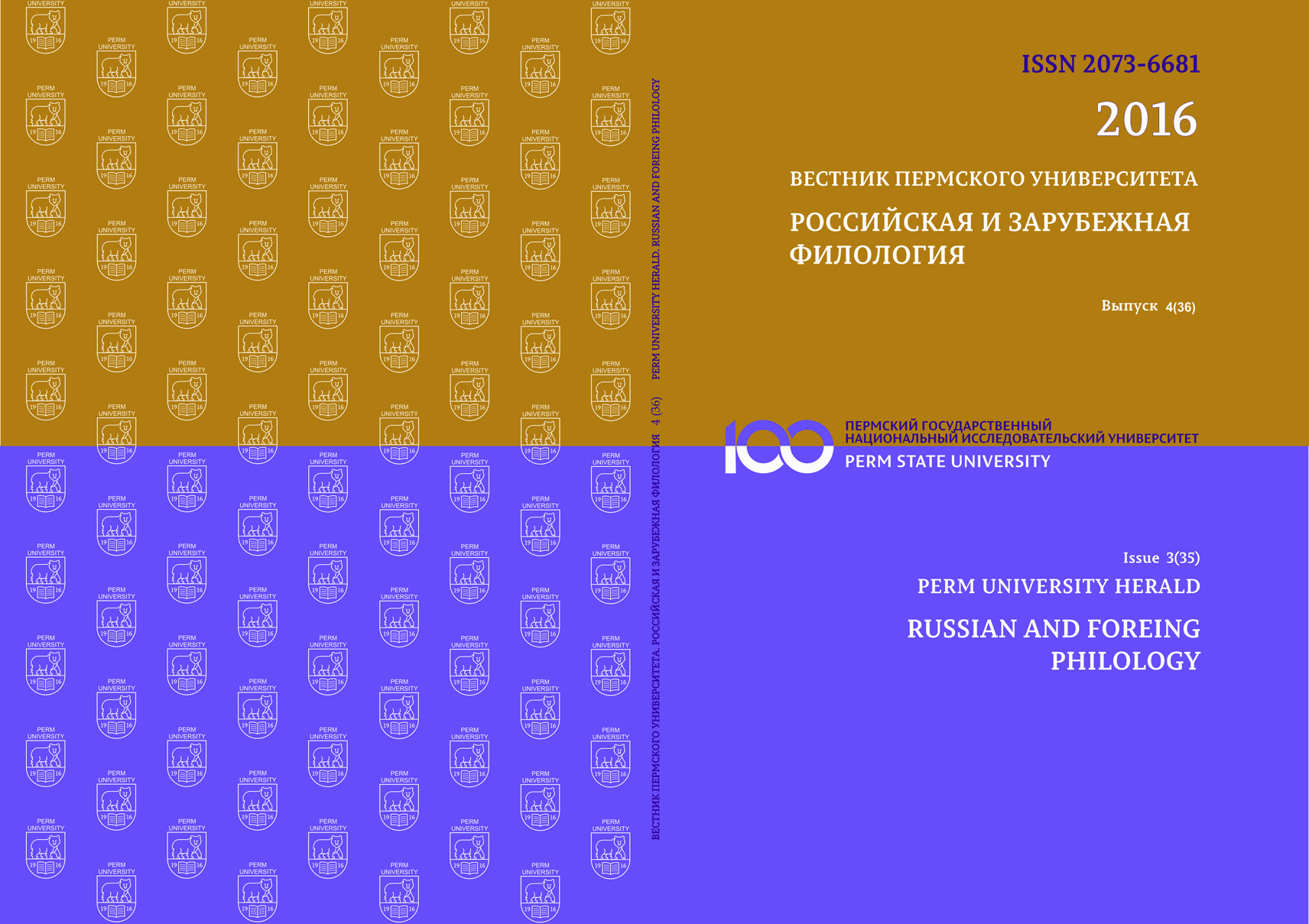ЛИНГВИСТИЧЕСКИЕ ПАРАМЕТРЫ КОНЦЕПТОВ "LIST" И "CATALOG": ВАРИАНТ ОБРАБОТКИ ЯЗЫКА ДЛЯ КОМПЬЮТЕРНЫХ СИСТЕМ
DOI:
https://doi.org/10.17072/2037-6681-2016-4-75-82Ключевые слова:
компьютерная лингвистика, логистическая регрессия, сравнительный анализ, семантика, близкие по значению понятия.Аннотация
В статье рассматриваются два близких по значению понятия, отражающие мировоззрение человека. Целью работы является определение наиболее подходящего концепта для его дальнейшего применения в качестве упорядочивающей или перечислительной единицы в семантических исследованиях. Эти единицы существуют независимо от наблюдателя и могут проявляться в системе различий и противопоставлений. С учетом нашего предположения, выделяем LIST и CATALOG как близкие по значению слова с целью выявления факторов, определяющих выбор того или иного концепта, исходя из объективных семантических критериев. С этой целью проводится предварительная разработка схемы логистического регрессионного анализа. В центре внимания оказывается выявление содержания и динамики понятий LIST и CATALOG с позиций (1) четырех стилевых регистров языка (академического, разговорного, литературного, газетного), (2) семантического признака притяжательного значения, (3) семантического признака единственного/множественного числа, (4) постмодификаций, (5) премодификаций и (6) конструкций родительного падежа.Библиографические ссылки
Barker Ch. Possessive Descriptions. Stanford: CSLI Publications, 1995. 194 p.
Beaver D. Presupposition and Assertion in Dynamic Semantics. Stanford: CSLI Publications, 2001. 305 p.
Biber D., Conrad S., Leech G. Longman Grammar of Spoken and Written English. Pearson, 2002. 1204 p.
Charles W. G. Contextual Correlates of Meaning // Applied Psycholinguistics/ 2000. № 21(4). P. 505–524.
Collins – Collins English Dictionary / Ed. by London: Harper Collins, 1994. 1791 p.
Collins – The New Collins Thesaurus / Ed. by William T. McLeod, London: Collins, 2002. 759 p.
Church K. W., Gale W., Hanks P., Hindle D., Moon R. Lexical Substitutability // B. T. S. Atkins and A. Zampolli. Computational Approaches to the Lexicon. Oxford University Press, 1994. P. 153–177.
Davies M. The Corpus of Contemporary American English (COCA): 425 million words, 1990. URL: http://www.americancorpus.org (дата обращения: 11.06.2016).
Eco U. The infinity of lists. Pub: New York: Rizzoli, 2009. 408 p.
Farlex – Free Farlex Online Thesaurus of synonyms, antonyms, and related words. URL: http://
www.thefreedictionary.com/list (дата обращения: 09.06.2016).
Fillmore Ch. “The Case for Case”, In Universals in Linguistic Theory / Ed. by Emmon Bach and Robert T. Harms. New York: Holt, 1968. P. 49–50.
Gilquin G. Causative ‘get’ and ‘have’: So close, so different // Journal of English Linguistics. 2003. № 31(2). P. 125–148.
Glynn D. Mapping meaning. Towards a usage-based methodology in Cognitive Semantics. (Un-published doctoral dissertation). University of Leuven, 2007. 163 p.
Gries S. Th. A corpus-linguistic analysis of -ic and -ical adjectives // ICAME Journal. 2001. № 25. P. 65–108.
Gries S. Th. & Otani N. Behavioral profiles: A corpus-based perspective on synonymy and antonymy // ICAME Journal. 2010. № 34. P. 121–150.
Halliday M. A. K. Spoken and written modes of meaning / ed. by Rosalind Horowitz and S. Jay Samuels. Comprehending Oral and Written Lan-guage. New York: Academic Press, 1987. P. 55–82.
Hunston S. Corpora in applied linguistics. Cambridge: Cambridge University Press, 2002. 241 p.
Labov W. The recent history of some dialect markers on the island of Martha’s Vineyard Mass / ed. by L. M. Davis. Studies in Linguistics in Honor of Raven I. McDavid Jr. University, Alabama Press. with Malcah Yaeger & Richard Steiner. A Quantitative Study of Sound Change in Progress. Philadelphia: U. S. Regional Survey, 1972. P. 1–31.
Levshina N., Geeraerts D., Speelman D. Dutch causative constructions with doen and laten: Quantification of meaning and meaning of quantification / ed. by D. Glynn & J. Robinson. Corpus Methods for Semantics: Quantitative studies in polysemy and synonymy. Amsterdam: John Benjamins, 2014. P. 377–414.
Longman – Longman Dictionary of Contemporary English. Fifth edition / Ed.: Harlow, Pearson, 2009. 2081 p.
Lyons J. Introduction to Theoretical Lingusitics. Cambridge University Press, 1968. P. 394–395.
Miller G. A., Walter G. Ch. Contextual correlates of semantic similarity. Language and Cognitive Processes. 1991. № 6(1). P. 1–28.
Peters S. The Semantics of Possessives. Stanford University Press, 2013. 64 p.
Phoocharoensil S. A. Corpus-Based Study of English Synonyms. International Journal of Arts and Sciences. 2010. № 3(10). P. 227–245.
Webster – Random house Webster’s college dictionary. Ed.: New York: Random House, 1996. 1567 p.
Shumaker W. The Semantics of the English’s Genitive // American Speech. Vol. 50. № 1/2 Spring – Summer. Duke University Press Stable. 1975. P. 70–86.
Speelman D. Logistic regression: A confirmatory technique for comparisons in corpus linguistics. // Ed. by Glynn D. and Robinson J. Corpus Methods in Cognitive Semantics, Amsterdam: John Benjamins, 2012. P. 181–231.
The New Shorter Oxford English Dictionary on Historical Principles: in 2 vols. / Ed. By Brown L., Little W., Onions C. T. George Washington Salisbury Friedrichsen, Vol. 1 A–M; Vol. 2 N–Z, Oxford: Clarendon, 1993. 3801 p.
Varantola K. On Noun Phrase Structures in Engineering English, Annales Universitatis Turkuensis, Ser. B, Tom. 168), Edité par Turun Ylopisto Turku, 1984. 252 p.




